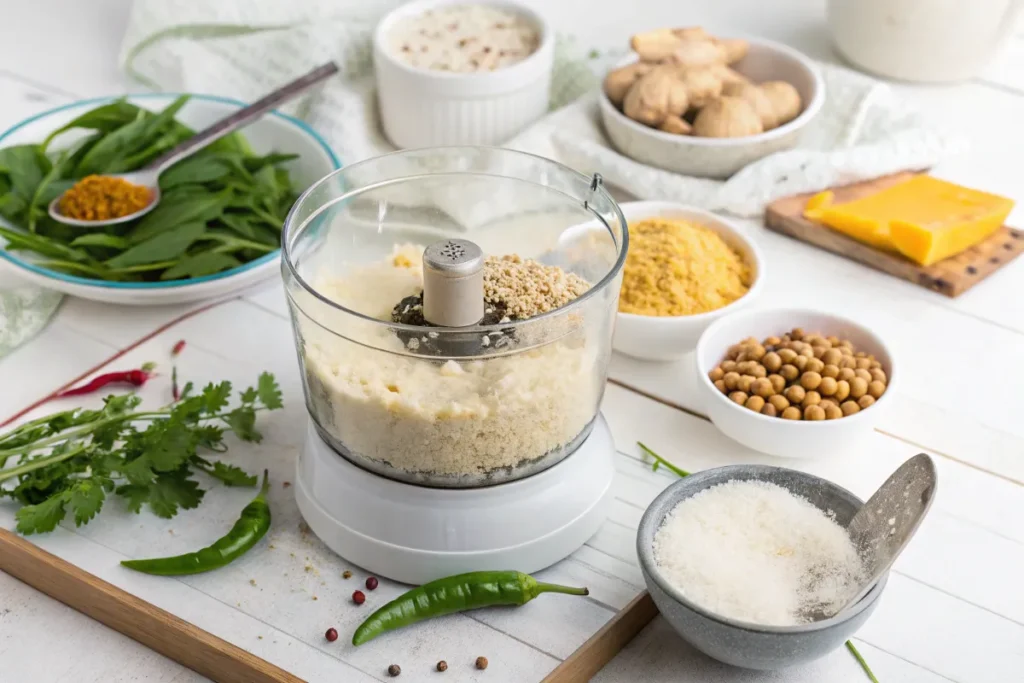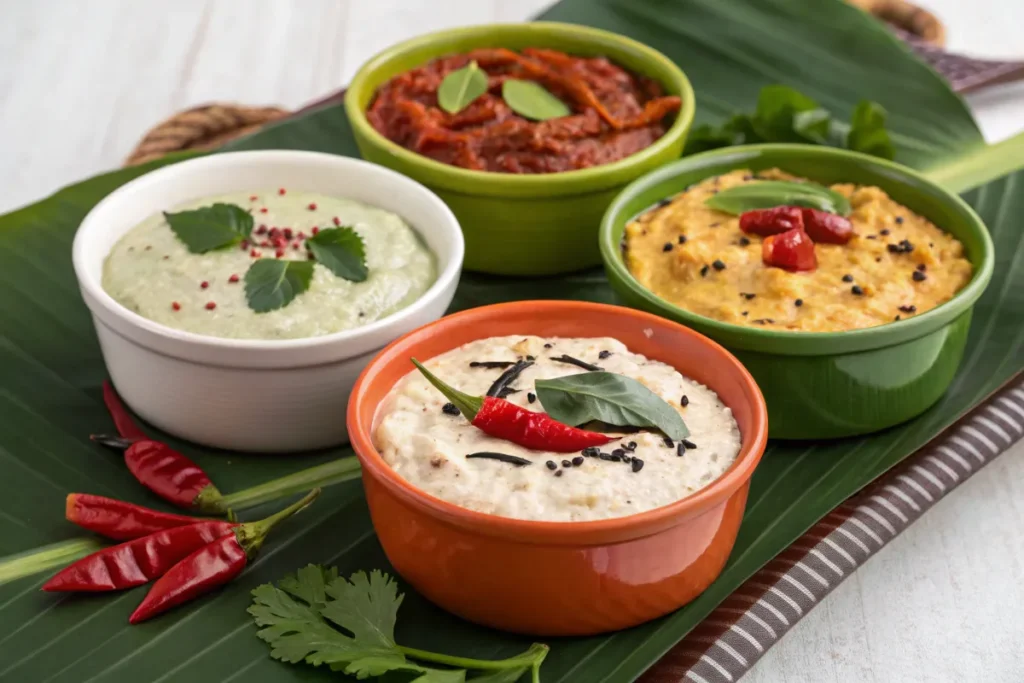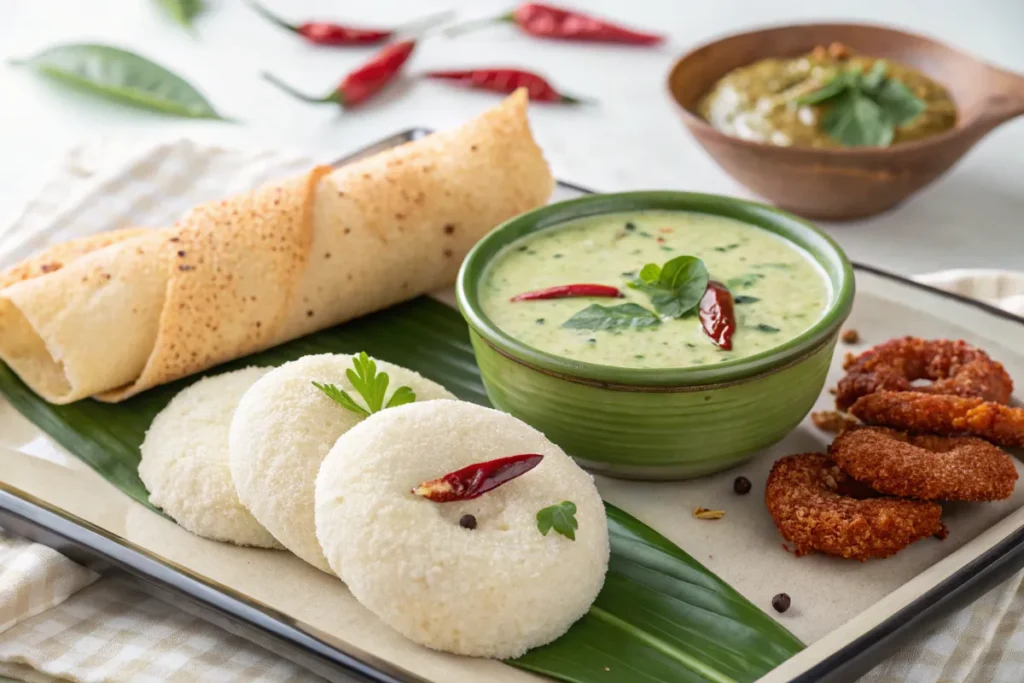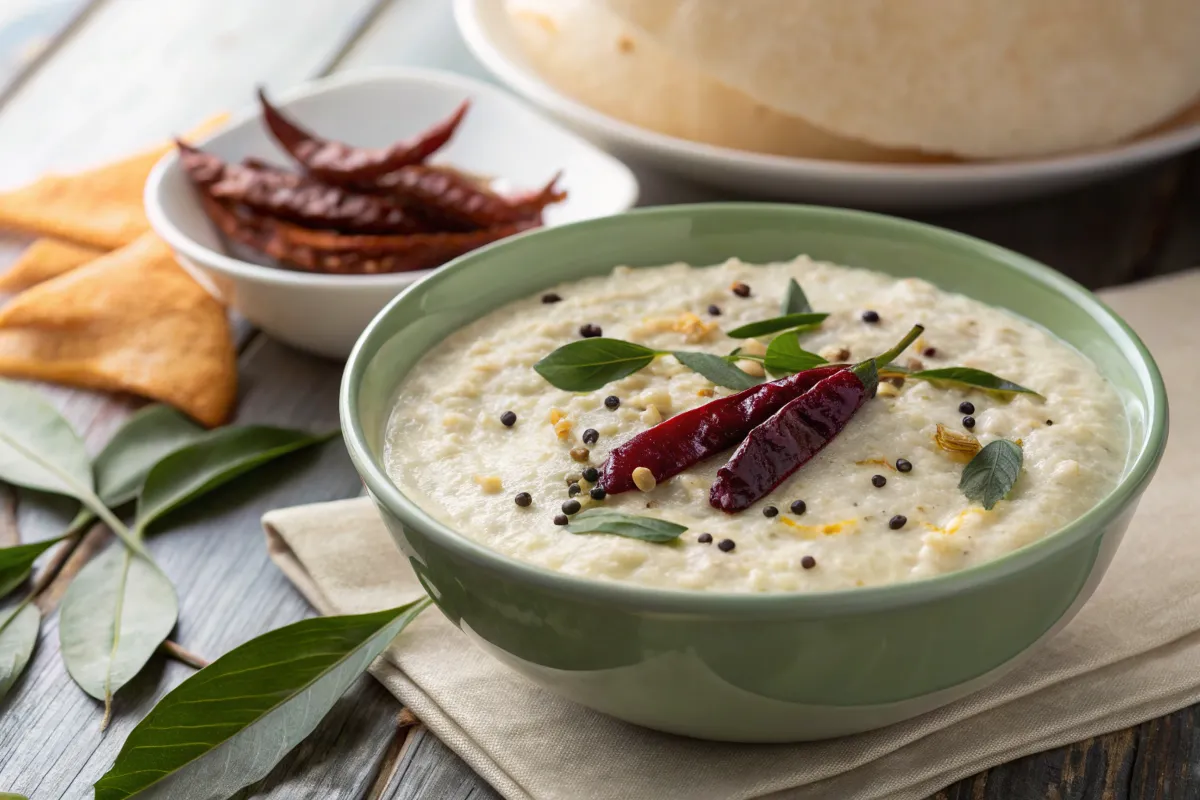Introduction
If you’ve ever indulged in a traditional South Indian meal, you know that coconut chutney is an essential part of the experience. This coconut chutney recipe is not just a simple accompaniment; it’s a game-changer that elevates dishes like idli, dosa, uttapam, and vada to a whole new level. With its creamy texture and a burst of flavors, it’s no wonder that this chutney has become a staple not only in South India but all around the world.
In this ultimate guide, we’ll dive into everything you need to know about making the perfect coconut chutney recipe. From understanding what makes this chutney so special to exploring various types like red coconut chutney, green coconut chutney, and hotel-style coconut chutney, we’ll cover it all. You’ll also learn pro tips for blending, tempering techniques to boost flavor, and even a few regional variations to spice things up.
Plus, we’ll tackle common questions about storage, serving ideas, and why your chutney might taste bitter sometimes. Ready to make a chutney that’ll impress everyone at the table? Let’s get started!
Introduction to Coconut Chutney
What is Coconut Chutney?
Coconut chutney is a classic South Indian condiment made from freshly grated coconut, roasted gram dal, green chilies, ginger, and salt, all blended together to create a smooth, creamy texture. The chutney is typically tempered with mustard seeds, curry leaves, and dried red chilies to enhance the flavor and add a bit of crunch.
This chutney is famous for its cool, refreshing taste that perfectly balances the spicy and savory flavors of South Indian dishes. Whether served with steamed idli, crispy dosa, or even as a dip for Medu Vada, this versatile chutney adds a burst of freshness to any meal.
Why Coconut Chutney is a Must-Have Side Dish
There’s just something irresistible about coconut chutney that makes it a must-have on your plate. It’s:
- Flavorful and Creamy: The smooth texture of coconut mixed with bold spices creates a harmonious blend of flavors.
- Versatile: It pairs beautifully with a wide range of dishes, from dosas and idlis to paniyarams and upmas.
- Quick and Easy: Takes just a few minutes to whip up, making it an ideal choice for busy mornings or last-minute meals.
- Customizable: Adjust the spice levels and ingredients to suit your preferences—whether you like it mild, spicy, or extra tangy.
Traditional Uses and Pairings
While coconut chutney is most commonly served as a side dish for South Indian breakfast items, it also works well with:
- Rice dishes: Especially with lemon rice and tamarind rice.
- Snacks: Like paniyaram, pakoras, and bonda.
- Fusion Recipes: Use it as a dip for veggie sticks or even as a spread on sandwiches for a unique twist.
Variations and Regional Differences
Different regions across South India put their unique spin on the coconut chutney recipe. Some prefer a touch of tamarind for tanginess, while others add mint and cilantro for a fresh, herbal flavor. You might come across:
- Red Coconut Chutney: Made with dried red chilies and urad dal, giving it a vibrant color and spicy punch.
- Green Coconut Chutney: Features mint, coriander, and green chilies for a refreshing taste.
- Roasted Coconut Chutney: Uses roasted coconut for a deeper, nuttier flavor.
- Hotel-Style Coconut Chutney: Smooth and creamy, often served in restaurants and tiffin centers.
🔥 Pro Tip: Experiment with different ingredients to create your own version of coconut chutney. Add some ginger for a zing, or use roasted peanuts for a nutty twist!
Coconut chutney is a classic South Indian condiment made from freshly grated coconut, roasted gram dal, green chilies, ginger, and salt. It’s traditionally served with idli, dosa, and other breakfast favorites. Learn more about traditional South Indian chutneys to explore different chutney varieties and preparation methods.
Essential Ingredients for Coconut Chutney Recipe
Creating a delicious coconut chutney recipe starts with gathering the right ingredients. The beauty of this chutney lies in its simplicity and freshness, yet a few key components make all the difference. Let’s break down what you’ll need.
Primary Ingredients for Authentic Flavor
For the most traditional and flavorful coconut chutney, make sure to use these essential ingredients:
- Fresh Grated Coconut (1 cup): The star of the show, providing a rich, creamy base.
- Roasted Gram Dal (2 tablespoons): Adds a nutty texture and thickness to the chutney.
- Green Chilies (2-3): Offers that spicy kick typical of South Indian cuisine.
- Ginger (1-inch piece): Adds a subtle zesty freshness to balance the heat.
- Salt (to taste): Essential for enhancing the overall flavor.
- Water (as needed): Adjust for your preferred consistency.
🔥 Pro Tip: Use freshly grated coconut rather than frozen or desiccated to get the most authentic flavor and texture.
Optional Ingredients to Elevate the Taste
While the basic coconut chutney recipe is undeniably tasty, adding a few optional ingredients can take it to the next level:
- Tamarind Pulp (1 teaspoon): Adds a tangy twist that brightens the chutney.
- Curry Leaves (a few): Infuses a signature South Indian aroma.
- Cilantro (a handful): Blends in a herbal note and a touch of vibrant green.
- Garlic Cloves (1-2): Adds a robust, savory depth to the chutney.
- Yogurt (2 tablespoons): Makes the chutney creamier and balances the spice.
Choosing Fresh Coconut for the Best Results
The quality of coconut significantly impacts the flavor and texture of your coconut chutney recipe. Here’s how to select the best:
- Look for Freshness: The coconut should feel heavy, indicating it has plenty of moisture inside.
- Check the Shell: Shake it to hear the water sloshing—a sign it’s still fresh.
- Avoid Cracks: Cracked or moldy shells indicate that the coconut may be spoiled.
🔥 Pro Tip: If you can’t find fresh coconut, opt for frozen grated coconut instead of dried. It retains the natural flavor and moisture much better.
How to Prepare Coconut Chutney

Now that you’ve gathered your ingredients, it’s time to whip up the best coconut chutney recipe. The process is quick and straightforward, but a few techniques make all the difference in achieving the perfect texture and flavor.
Basic Preparation Steps
- Gather Your Ingredients: Have everything ready and measured out before you begin.
- Blend the Ingredients: In a blender, add grated coconut, roasted gram dal, green chilies, ginger, and salt.
- Add Water: Pour in a little water and blend until smooth. Adjust water quantity to reach your desired consistency.
- Taste and Adjust: Check the seasoning and add more salt or chilies as needed.
- Tempering (Optional but Recommended): Heat oil in a small pan, add mustard seeds, dried red chilies, curry leaves, and urad dal, and pour the sizzling tempering over the chutney.
🔥 Pro Tip: If the chutney is too thick, gradually add more water while blending to achieve a smooth, creamy consistency.
Blending Techniques for a Smooth Texture
Getting that velvety texture can be a bit tricky, but these tips will help:
- Pulse First: Instead of blending continuously, use the pulse function to break down the ingredients.
- Add Water Slowly: Pour water in small increments to avoid making the chutney too runny.
- Use a High-Powered Blender: A good-quality blender ensures a smooth and creamy consistency without leaving chunks.
Adjusting the Consistency of Chutney
The texture of coconut chutney varies depending on how you plan to serve it:
- Thick and Chunky: Ideal for pairing with dosa or idli.
- Smooth and Runny: Works well as a dipping sauce for vada or pakoras.
- Slightly Coarse: Perfect for rice dishes like lemon rice or tamarind rice.
🔥 Pro Tip: If your chutney turns out too thin, add a tablespoon of roasted gram dal and blend again.
For more mouthwatering dishes featuring coconut, check out this Coconut Cookies Recipe on Bussing Recipes! 🍪🌴
Popular Types of Coconut Chutney

The coconut chutney recipe is incredibly versatile, with various regional and flavor adaptations. Whether you prefer it classic, spicy, or with a twist, there’s a version for everyone. Let’s explore the most popular types of coconut chutney and how to make each one.
1. Classic White Coconut Chutney
This is the most traditional and widely-loved version of the coconut chutney recipe. It’s creamy, mildly spiced, and perfect with dishes like idli and dosa.
Ingredients and Preparation
- Fresh grated coconut (1 cup)
- Roasted gram dal (2 tablespoons)
- Green chilies (2)
- Ginger (1-inch piece)
- Salt (to taste)
- Water (as needed)
Preparation:
- Blend all ingredients with water to form a smooth, creamy paste.
- Adjust the consistency with additional water if needed.
- Temper with mustard seeds, curry leaves, and dried red chilies.
🔥 Pro Tip: Use freshly grated coconut for a richer, more authentic taste.
Serving Suggestions and Pairings
Serve this classic white coconut chutney with:
- Steamed idli
- Crispy dosa
- Vada and pongal
- Uttapam
2. Red Coconut Chutney
Looking for something with a bit of heat and a bold color? The red coconut chutney recipe uses dried red chilies for an eye-catching, spicy version.
The Secret to Achieving Vibrant Color
The secret lies in using Kashmiri red chilies or Byadgi chilies. These chilies provide a vibrant red color without making the chutney overly spicy.
Ingredients:
- Grated coconut (1 cup)
- Dried red chilies (4-5)
- Roasted gram dal (2 tablespoons)
- Garlic (1-2 cloves)
- Salt (to taste)
- Tamarind (small piece)
- Water (as needed)
Preparation:
- Soak dried red chilies in hot water for 10 minutes.
- Blend with the other ingredients to form a smooth paste.
- Temper with mustard seeds and curry leaves for a finishing touch.
🔥 Pro Tip: Adjust the number of chilies to control the spice level.
3. Green Coconut Chutney
This herb-infused version is refreshing and adds a pop of color to your plate. The green coconut chutney recipe uses cilantro and mint for a unique, herbal flavor.
Adding Fresh Herbs for a Unique Twist
By incorporating cilantro and mint, this chutney gets a bright, zesty flavor that pairs beautifully with snacks and tiffin items.
Ingredients:
- Grated coconut (1 cup)
- Green chilies (2)
- Fresh cilantro (1/4 cup)
- Mint leaves (a handful)
- Ginger (1-inch piece)
- Salt (to taste)
- Water (as needed)
Preparation:
- Blend all ingredients until smooth.
- Add more water if the chutney is too thick.
- Temper with mustard seeds, curry leaves, and a pinch of asafoetida.
🔥 Pro Tip: Add a dash of lemon juice to enhance the fresh flavors.
4. Roasted Coconut Chutney
Roasting the coconut adds a deep, nutty flavor that takes the coconut chutney recipe to the next level. This version is smoky and rich, making it a fantastic side dish for grilled and fried items.
How Roasting Changes the Flavor Profile
Roasting gives the chutney a toasted, slightly caramelized flavor that adds depth to the dish. It’s especially great with hearty meals like masala dosa or stuffed paratha.
Ingredients:
- Grated coconut (1 cup)
- Roasted gram dal (2 tablespoons)
- Dried red chilies (2-3)
- Garlic (2 cloves)
- Salt (to taste)
- Oil (1 tablespoon)
- Water (as needed)
Preparation:
- Heat oil in a pan and roast the coconut, chilies, and garlic until golden brown.
- Let it cool and blend with other ingredients and water to a smooth paste.
- Temper with mustard seeds and curry leaves.
🔥 Pro Tip: Roasting coconut in ghee instead of oil gives a richer flavor.
Tempering Coconut Chutney for Extra Flavor
Tempering is a game-changer when it comes to enhancing the flavor and aroma of your coconut chutney recipe. It’s a simple step that adds depth and complexity to the dish.
Why Tempering Enhances Taste and Aroma
Tempering involves frying spices and herbs in hot oil to release their natural oils and aromas. This infused oil is then poured over the chutney to boost both flavor and texture.
Ingredients for the Perfect Tempering
To create an authentic tempering, you’ll need:
- Oil (1 tablespoon)
- Mustard seeds (1 teaspoon)
- Urad dal (1 teaspoon)
- Dried red chilies (2)
- Curry leaves (a handful)
- Asafoetida (a pinch)
Step-by-Step Tempering Process
- Heat oil in a small pan on medium heat.
- Add mustard seeds and let them splutter.
- Add urad dal and dried red chilies, sautéing until the dal turns golden.
- Toss in curry leaves and a pinch of asafoetida, allowing them to sizzle for a few seconds.
- Pour the tempering directly over the prepared chutney and mix gently.
🔥 Pro Tip: Always pour the hot tempering over the chutney immediately to lock in the flavors.
Tempering truly transforms the coconut chutney recipe, giving it a professional touch and a fragrant finish. Whether you’re serving it with idlis or parathas, the right tempering makes all the difference!
Tips and Tricks for the Perfect Coconut Chutney Recipe
Mastering the coconut chutney recipe isn’t just about following the steps. It’s also about knowing the little secrets that make a big difference. Whether you’re a beginner or an experienced cook, these tips and tricks will help you create a chutney that’s bursting with flavor every time.
How to Prevent Chutney from Spoiling
One common problem with coconut chutney is that it tends to spoil quickly, especially in warm climates. Here’s how to keep it fresh for longer:
- Add Tamarind or Lemon Juice: The acidity helps preserve the chutney and slows down spoilage.
- Refrigerate Immediately: Store the chutney in an airtight container and place it in the fridge as soon as it’s prepared.
- Avoid Using Wet Spoons: Always use dry, clean spoons when serving to prevent contamination.
- Temper Right Before Serving: If you’re making the chutney in advance, temper it just before serving to maintain freshness.
🔥 Pro Tip: Adding a little yogurt to the chutney can also enhance its shelf life while giving it a creamy texture.
Storing Coconut Chutney for Extended Freshness
Storing your coconut chutney recipe correctly is crucial to preserving its taste and texture. Here’s what you need to know:
- Short-Term Storage: Refrigerate in an airtight container for up to 2-3 days.
- Freezing: Freeze the chutney in small portions to use as needed. Thaw and add a fresh tempering before serving.
- Glass Jars Over Plastic: Use glass containers to maintain flavor and avoid any odor absorption.
🔥 Pro Tip: If your chutney becomes too thick after refrigeration, add a splash of warm water and whisk it well to revive the creamy texture.
Ways to Balance the Spice and Tanginess
Not everyone loves an overly spicy or tangy coconut chutney. Here’s how to adjust the flavors to suit your preference:
- Too Spicy? Add a little yogurt or coconut milk to mellow down the heat.
- Too Tangy? Balance it out with a pinch of sugar or a little more grated coconut.
- Lacks Depth? Add a few roasted peanuts or cashews to give a nutty richness.
🔥 Pro Tip: Always taste and adjust the seasoning before tempering, as flavors tend to intensify after resting.
Best Ways to Serve Coconut Chutney

The beauty of a coconut chutney recipe lies not only in how it’s made but also in how it’s served. This versatile chutney can elevate the taste of many dishes, whether traditional or fusion. Let’s explore the best ways to serve coconut chutney to make your meal truly memorable.
Popular Pairings: Idli, Dosa, and More
Coconut chutney pairs exceptionally well with a variety of South Indian dishes, making it a staple in many households and restaurants. Here are some of the most popular combinations:
- Idli: Soft, steamed rice cakes are perfectly complemented by the creamy chutney.
- Dosa: Whether it’s a plain dosa, masala dosa, or rava dosa, coconut chutney adds a cooling contrast to the crispy texture.
- Uttapam: The chutney’s light, fresh flavor pairs well with the thick, pancake-like texture of uttapam.
- Medu Vada: The crispy, savory fritters dunked in coconut chutney are a match made in heaven.
- Upma: A hearty breakfast of upma becomes even better with a side of fresh coconut chutney.
🔥 Pro Tip: Serve the chutney slightly chilled with hot dishes to create a delightful contrast.
Creative Uses Beyond Traditional Meals
While coconut chutney is often served with South Indian staples, don’t limit yourself—get creative! Here are some unique ways to use this delicious condiment:
- Sandwich Spread: Use it as a flavorful spread for veggie or chicken sandwiches.
- Dipping Sauce: Serve with crispy snacks like pakoras, samosas, or fries for a refreshing twist.
- Salad Dressing: Thin it out with a little water and drizzle over cucumber or cabbage salads.
- Wrap Filling: Use it as a sauce in wraps with grilled veggies or chicken.
- Fusion Tacos: Pair with spicy chicken or paneer tacos for an Indian-Mexican fusion.
Garnishing Ideas for Visual Appeal
Adding a few finishing touches can make your coconut chutney recipe look even more inviting. Here are some simple garnishing ideas:
- Curry Leaves and Mustard Seeds: These are classic toppings that add both flavor and a pop of color.
- Red Chili Flakes: Sprinkle lightly for a fiery hint and visual appeal.
- Fresh Coriander: A touch of green from chopped cilantro brightens up the chutney.
- Toasted Coconut Flakes: Adds a textural contrast and a hint of sweetness.
🔥 Pro Tip: Serve the chutney in a decorative bowl with a drizzle of tempered oil on top for that restaurant-style presentation.
Whether you’re serving coconut chutney with traditional dishes or modern creations, its versatility and fresh taste make it a must-have. Plus, with these tips and creative ideas, you can turn a simple condiment into a flavor-packed side dish that everyone will love.
Next up: Regional Variations and Unique Twists on Coconut Chutney! 🌿🥥
Coconut Chutney Recipe Variations from Different Regions
One of the best things about the coconut chutney recipe is its incredible versatility. Across South India and beyond, you’ll find unique regional variations that offer a fresh twist on the classic. Let’s explore some of the most popular styles and how they differ from one another.
South Indian Style Coconut Chutney
The South Indian coconut chutney is the most traditional version and is commonly served in homes and restaurants alike. It’s known for its creamy texture and balanced flavor, with a hint of spice and nuttiness.
Ingredients:
- Grated coconut (1 cup)
- Roasted gram dal (2 tablespoons)
- Green chilies (2)
- Ginger (1-inch piece)
- Salt (to taste)
- Water (as needed)
Preparation:
- Blend all ingredients together to form a smooth paste.
- Add tempering of mustard seeds, curry leaves, and dried red chilies.
- Serve chilled with idli, dosa, or vada.
🔥 Pro Tip: Add a pinch of asafoetida to the tempering for a subtle, savory kick.
Kerala-Style Coconut Chutney
Kerala-style chutney stands out for its bold flavors and vibrant red color. This version is usually made with dried red chilies and has a slightly tangy note from tamarind.
Ingredients:
- Grated coconut (1 cup)
- Dried red chilies (4-5)
- Shallots (2)
- Tamarind (small piece)
- Salt (to taste)
- Water (as needed)
Preparation:
- Blend the grated coconut, chilies, shallots, tamarind, and salt into a coarse paste.
- Temper with coconut oil, mustard seeds, curry leaves, and dried red chilies.
- Serve with puttu, appam, or rice.
🔥 Pro Tip: Using coconut oil in the tempering enhances the authentic Kerala flavor.
Tamil Nadu Special Coconut Chutney
Tamil Nadu’s version of the coconut chutney recipe is typically mild and creamy, often served with hot, fluffy idlis and crispy dosas. It’s known for its subtle ginger and green chili notes.
Ingredients:
- Grated coconut (1 cup)
- Green chilies (3)
- Ginger (1-inch piece)
- Roasted gram dal (2 tablespoons)
- Salt (to taste)
- Water (as needed)
Preparation:
- Blend all ingredients into a smooth, thick chutney.
- Temper with mustard seeds, curry leaves, and a pinch of asafoetida.
- Serve with idli, dosa, or pongal.
🔥 Pro Tip: Adding a touch of urad dal to the tempering gives it a crunchy texture.
Hotel-Style Coconut Chutney
Hotel-style coconut chutney is often served in tiffin centers and restaurants, and it’s slightly sweeter and creamier than homemade versions. It pairs exceptionally well with crispy dosas and vadas.
Ingredients:
- Grated coconut (1 cup)
- Pottukadalai (roasted gram) (3 tablespoons)
- Green chilies (2)
- Garlic (1 clove)
- Salt (to taste)
- Water (as needed)
Preparation:
- Blend all ingredients until smooth and creamy.
- Temper with mustard seeds, curry leaves, and a dash of oil.
- Serve with a dollop of ghee on top for extra flavor.
🔥 Pro Tip: Adding a teaspoon of yogurt makes the chutney super creamy and restaurant-like.
Frequently Asked Questions (FAQs)
Even with a well-explained coconut chutney recipe, you might still have some questions. Here are the most commonly asked questions and their answers to help you out!
Can I Make Coconut Chutney Without Fresh Coconut?
Absolutely! If fresh coconut is not available, you can use frozen grated coconut or even desiccated coconut. Just soak the desiccated coconut in warm water for a few minutes before blending. Although the flavor may vary slightly, it’s a great alternative when you’re short on fresh ingredients.
Why Does My Coconut Chutney Taste Bitter?
Bitterness in coconut chutney usually comes from stale or spoiled coconut. Make sure your coconut is fresh and moist. Another reason could be over-roasting the gram dal or burning the tempering spices. Always cook tempering ingredients on low to medium heat to avoid burning.
How Long Can I Store Coconut Chutney in the Fridge?
Typically, coconut chutney can be stored in an airtight container in the fridge for up to 2-3 days. To maintain freshness, avoid keeping it at room temperature for too long. Always use a clean spoon to scoop out the chutney to minimize contamination.
🔥 Pro Tip: If storing for longer, avoid adding tempering initially. Temper the chutney just before serving to keep it fresh and flavorful.
Can I Freeze Coconut Chutney for Later Use?
Yes, you can freeze coconut chutney, but be aware that the texture may change slightly after thawing. To preserve the best quality:
- Divide the chutney into small portions and place them in freezer-safe containers.
- When ready to use, thaw in the refrigerator overnight.
- Blend the thawed chutney again with a bit of warm water to restore its consistency.
- Add a fresh tempering to revive the flavor before serving.
And there you have it—the ultimate guide to making the perfect coconut chutney recipe with regional variations and helpful tips. Whether you prefer it mild, spicy, roasted, or herb-infused, there’s a version that suits every palate. Try these amazing chutney variations with your favorite South Indian dishes and enjoy the burst of flavors!
Happy cooking! 🥥🌿

